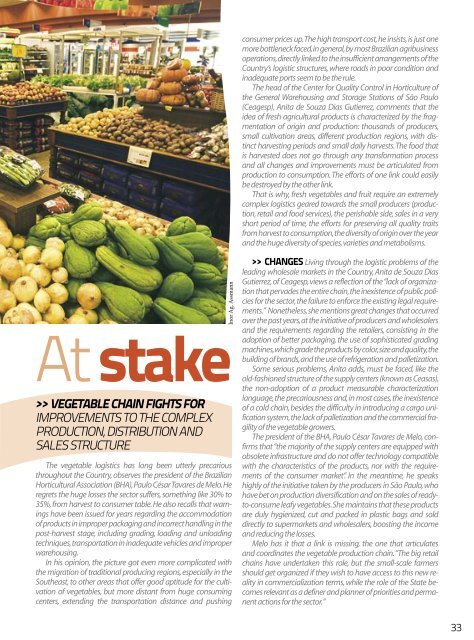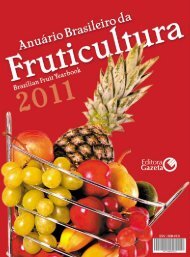tradicionalmenteinovador - Brazil Buyers & Sellers
tradicionalmenteinovador - Brazil Buyers & Sellers
tradicionalmenteinovador - Brazil Buyers & Sellers
Create successful ePaper yourself
Turn your PDF publications into a flip-book with our unique Google optimized e-Paper software.
consumer prices up. The high transport cost, he insists, is just one<br />
more bottleneck faced, in general, by most <strong>Brazil</strong>ian agribusiness<br />
operations, directly linked to the insufficient arrangements of the<br />
Country’s logistic structures, where roads in poor condition and<br />
inadequate ports seem to be the rule.<br />
The head of the Center for Quality Control in Horticulture of<br />
the General Warehousing and Storage Stations of São Paulo<br />
(Ceagesp), Anita de Souza Dias Gutierrez, comments that the<br />
idea of fresh agricultural products is characterized by the fragmentation<br />
of origin and production: thousands of producers,<br />
small cultivation areas, different production regions, with distinct<br />
harvesting periods and small daily harvests. The food that<br />
is harvested does not go through any transformation process<br />
and all changes and improvements must be articulated from<br />
production to consumption. The efforts of one link could easily<br />
be destroyed by the other link.<br />
That is why, fresh vegetables and fruit require an extremely<br />
complex logistics geared towards the small producers (production,<br />
retail and food services), the perishable side, sales in a very<br />
short period of time, the efforts for preserving all quality traits<br />
from harvest to consumption, the diversity of origin over the year<br />
and the huge diversity of species, varieties and metabolisms.<br />
At stake<br />
>> Vegetable chain fights for<br />
improvements to the complex<br />
production, distribution and<br />
sales structure<br />
The vegetable logistics has long been utterly precarious<br />
throughout the Country, observes the president of the <strong>Brazil</strong>ian<br />
Horticultural Association (BHA), Paulo César Tavares de Melo. He<br />
regrets the huge losses the sector suffers, something like 30% to<br />
35%, from harvest to consumer table. He also recalls that warnings<br />
have been issued for years regarding the accommodation<br />
of products in improper packaging and incorrect handling in the<br />
post-harvest stage, including grading, loading and unloading<br />
techniques, transportation in inadequate vehicles and improper<br />
warehousing.<br />
In his opinion, the picture got even more complicated with<br />
the migration of traditional producing regions, especially in the<br />
Southeast, to other areas that offer good aptitude for the cultivation<br />
of vegetables, but more distant from huge consuming<br />
centers, extending the transportation distance and pushing<br />
Inor Ag. Assmann<br />
>> CHANGES Living through the logistic problems of the<br />
leading wholesale markets in the Country, Anita de Souza Dias<br />
Gutierrez, of Ceagesp, views a reflection of the “lack of organization<br />
that pervades the entire chain, the inexistence of public policies<br />
for the sector, the failure to enforce the existing legal requirements.”<br />
Nonetheless, she mentions great changes that occurred<br />
over the past years, at the initiative of producers and wholesalers<br />
and the requirements regarding the retailers, consisting in the<br />
adoption of better packaging, the use of sophisticated grading<br />
machines, which grade the products by color, size and quality, the<br />
building of brands, and the use of refrigeration and palletization.<br />
Some serious problems, Anita adds, must be faced, like the<br />
old-fashioned structure of the supply centers (known as Ceasas),<br />
the non-adoption of a product measurable characterization<br />
language, the precariousness and, in most cases, the inexistence<br />
of a cold chain, besides the difficulty in introducing a cargo unification<br />
system, the lack of palletization and the commercial fragility<br />
of the vegetable growers.<br />
The president of the BHA, Paulo César Tavares de Melo, confirms<br />
that “the majority of the supply centers are equipped with<br />
obsolete infrastructure and do not offer technology compatible<br />
with the characteristics of the products, nor with the requirements<br />
of the consumer market”. In the meantime, he speaks<br />
highly of the initiative taken by the producers in São Paulo, who<br />
have bet on production diversification and on the sales of readyto-consume<br />
leafy vegetables. She maintains that these products<br />
are duly hygienized, cut and packed in plastic bags and sold<br />
directly to supermarkets and wholesalers, boosting the income<br />
and reducing the losses.<br />
Melo has it that a link is missing, the one that articulates<br />
and coordinates the vegetable production chain. “The big retail<br />
chains have undertaken this role, but the small-scale farmers<br />
should get organized if they wish to have access to this new reality<br />
in commercialization terms, while the role of the State becomes<br />
relevant as a definer and planner of priorities and permanent<br />
actions for the sector.”<br />
33





